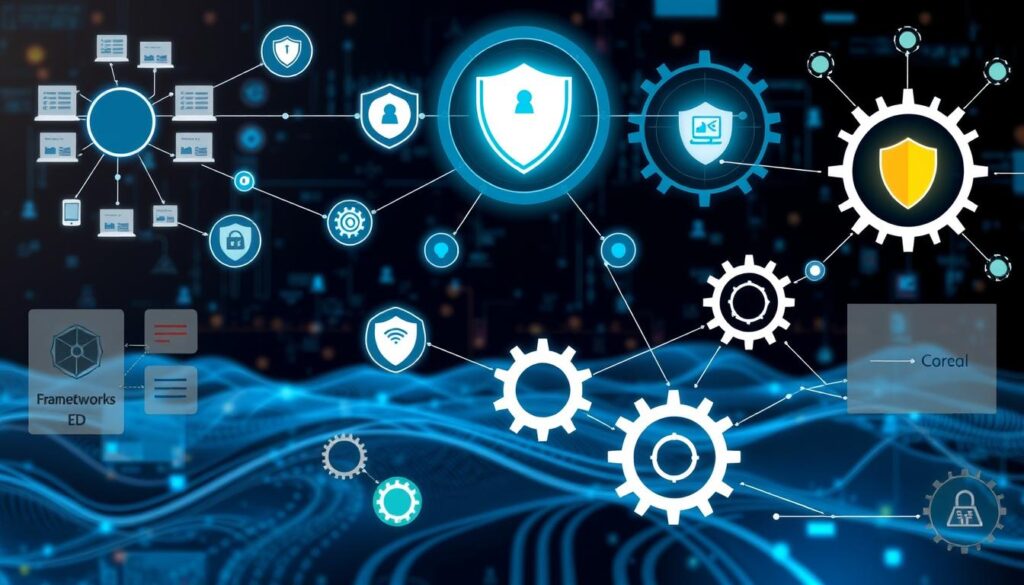
Did you know that companies without a clear security policy face up to a 60% higher risk of cyber-attacks? This shows how important good information security governance is today. With more threats and rules to follow, having a strong cybersecurity plan is key.
In this article, we’ll look at different information security governance models. These models can make your cybersecurity better. By learning about them, you can use the best IT governance practices. This helps lower risks and meet rules better. Let’s explore what makes good governance, the different models, and the best practices for a strong security.
What is Information Security Governance?
Information security governance is a key framework for organizations. It helps protect sensitive data by aligning resources and strategies. It focuses on clear policies and procedures to ensure everyone is accountable.
With more cybersecurity threats, a strong security governance framework is vital. It helps manage risks and keeps security plans in line with business goals. Companies must navigate complex threats by adopting strong cybersecurity policies.
Several elements are key to a good information security governance approach:
- Aligning security with business goals
- Putting in place effective security measures
- Supporting daily security operations
- Regularly checking and improving security practices
As data needs grow, so does the need for a solid information security governance program. These programs are essential for staying compliant with laws like GDPR and HIPAA. They also help protect against data breaches.
Importance of Information Security Governance
Understanding the importance of security governance is key for any organization. It helps protect data and follow rules. Studies show that about 90% of companies see it as vital for their cybersecurity.
A good plan not only reduces risks but also helps follow important rules in today’s digital world. This is critical for any business.
Companies with strong security governance are 50% less likely to face data breaches. This is compared to those with weak practices. As rules get more complex, about 60% of businesses find it hard to follow them without good governance.
So, having a solid governance structure is a big plus for your security strategy.
Having a dedicated security team can cut down incident response times by 40%. This shows how important quick and right actions are. Companies that check for risks regularly find problems 70% faster.
This helps them protect better and recover quicker. Those with clear plans for dealing with security issues can bounce back 30% faster. This shows the real benefits of good governance.
Also, about 75% of businesses say strong governance helps them follow industry rules better. Regular checks improve compliance by about 65%. This shows the ongoing effort needed to stay secure.
Setting up security committees helps spot threats better. Over 80% of members say they understand risks better. This is because they are more aware of the dangers.
Ignoring governance can lead to big cybersecurity problems. These issues cause about 45% of failures in companies. It’s important to get the executive team involved.
Their understanding of security policies affects how much they invest and how well governance works. Companies that use frameworks like ISO 27000 or the NIST Cybersecurity Framework do better. They protect their systems and meet rules more easily.
Key Components of Security Governance Models
Effective security governance models have key parts that work together to protect information. These parts include strong leadership, clear policies, a solid framework, and good risk management.
Leadership is key in pushing security efforts in an organization. Without it, security governance is hard to achieve. Clear policies and procedures guide employees on their security roles.
A good risk management framework is vital for spotting, checking, and fixing threats. It works with compliance to follow laws and standards. Having a plan for security incidents is also important to quickly handle problems and reduce damage.
Keeping an eye on security and reporting on it is important. Regular checks and training help keep strategies up to date. Training makes sure everyone knows how to keep security strong.
Managing risks from third parties is also key, for companies that work with outside partners. This part of governance deals with risks from these partnerships.
Here’s a table that shows these important parts:
| Component | Description |
|---|---|
| Leadership | Champions security initiatives and drives culture. |
| Policies & Procedures | Outlines clear expectations and responsibilities. |
| Security Governance Framework | Establishes structure for security practices. |
| Risk Management Strategies | Identifies and mitigates possible threats. |
| Compliance Management | Ensures alignment with laws and standards. |
| Incident Response Plan | Preparation for effective handling of incidents. |
| Continuous Monitoring | Evaluates ongoing effectiveness of security. |
| Training Programs | Educates employees on security best practices. |
| Third-Party Management | Manages risks from external partners and suppliers. |
Types of Information Security Governance Models
Organizations have many governance models to choose from for their information security. Knowing these models helps match security practices with your organization’s needs. The main types are centralized, decentralized, and hybrid models.
Centralized governance means one department makes all security decisions. This ensures everything is the same. It’s good for following rules and keeping risks low, but it might not be quick to change.
Decentralized governance lets each unit decide its own security. This makes it easier to react to threats. It’s great for big or international companies. But, it can lead to differences and more risks if not managed well.
Hybrid models mix centralized and decentralized. They’re good for big companies. Some things are done by one department, and others by local units. This way, you get both consistency and flexibility.
| Governance Model | Advantages | Disadvantages |
|---|---|---|
| Centralized Governance |
|
|
| Decentralized Governance |
|
|
| Hybrid Models |
|
|
Choosing a governance model depends on your company’s size, complexity, and security needs. Look at the good and bad of each model to find the best fit. The right model can really improve your security.

Centralized vs Decentralized Governance
It’s key to know the difference between centralized and decentralized security governance. A centralized model is good for places like banks and hospitals. It makes sure everyone follows the same security rules, keeping things in line.
But, this model can slow things down. It’s hard for big data or fast-changing markets. On the other hand, decentralized governance lets teams act fast. They can change data policies quickly, which is great for quick responses.
But, there’s a catch. Decentralized might lead to different rules in each area. This can cause data problems. Yet, it also means teams can make decisions faster, which is important.
Now, there’s a new trend: federated governance. It mixes the best of both worlds. It has a central plan but lets teams act on their own. Choosing the right model depends on what your company needs and what it’s up against.
Risk-Based Governance Models
Risk-based governance models focus on finding, checking, and fixing risks. This is key for companies wanting to protect their most important assets. They mix business goals with better security to get ready for threats.
Using risk management strategies well is vital for keeping things running smoothly. Companies that use these plans see fewer security problems. For example, studies show they are 35% better at stopping info security issues.
Doing regular risk checks, scanning for weaknesses, and modeling threats are important. These steps improve threat spotting and keep security up to date with business needs. Metrics and monitoring show how well security works and help make better choices.
A strong plan helps get ready for cyber threats. Following IT security standards like NIST and ISO 27001 makes a company’s security better. It also helps meet rules and regulations. Companies following these plans can cut costs by 10-20% in areas with lots of rules.
Companies moving to risk-based models should focus on ongoing training and updating plans. Keeping up with training and reviews boosts security awareness. This creates a culture of security. Being proactive protects data from hackers and makes the company stronger against threats.
Compliance-Based Governance Frameworks
Following compliance frameworks is key for companies wanting to meet legal standards. These frameworks offer structured ways to lower legal risks and set clear rules for operations. For example, GDPR, HIPAA, and PCI DSS are well-known frameworks. They all stress the need for protecting data.
About 90% of businesses struggle to balance compliance with making money, pleasing clients, and running smoothly. They need strong compliance frameworks to show they protect data and keep it safe.
It’s interesting that 74% of companies need a SOC 2 report because of contracts or to look good in the market. This shows how important compliance frameworks are for being seen as trustworthy and credible.
Companies face many compliance rules, like HIPAA, HITRUST, and NIST standards. These rules help manage sensitive data and follow federal laws. For example, HIPAA helps manage health info in the U.S. and is backed by federal law.
Using a good compliance framework makes things run smoother, cuts down on waste, and builds a culture focused on security. Frameworks like SOC 2 let companies adjust their strategies to fit their industry needs while staying safe from breaches.
Ignoring compliance frameworks can lead to big problems. Failing to follow GDPR can cost up to €20 million or 4% of annual revenue. CCPA violations can cost between $2,500 and $7,500 per issue. Companies must keep up with changing rules to avoid fines and protect their image.
Implementing Effective Information Security Governance Models
To start, assess your organization’s current security. This step helps find areas to improve. It’s key for setting up good security governance. Make clear goals and share them with everyone to get everyone on board.
Creating strong policies for security roles and procedures is important. Training employees well helps build a security-aware culture. Using IT governance best practices helps track and measure success. Regularly update your security plans to stay ahead of threats.

Good governance can really help. Companies with a solid framework see up to 70% fewer data breaches. Also, 64% of firms say their risk management has improved.
Aligning security goals with business objectives is critical. It boosts trust and transparency by 85%. Adopting a risk management framework can spot threats 50% better. Yet, 75% of companies struggle to link cybersecurity with their business plans.
Regular risk checks can cut incidents by 40%. Keeping security policies current helps manage risks better. Having a CISO can improve compliance by 50%.
Good governance boosts stakeholder confidence. It shows that investing in strong frameworks is key for data protection. Regular checks and updates can increase compliance by up to 80%.
| Governance Strategy | Benefits | Impact on Security Incidents |
|---|---|---|
| Formal Information Security Framework | Up to 70% reduction in breaches | Major decrease |
| Dedicated Governance Teams | 30% fewer incidents | Fewer security challenges |
| Regular Risk Assessments | Identifies vulnerabilities | 40% fewer incidents |
| Policy Updates | Agility in threat management | Improved incident response |
| Risk Management Framework | 50% better threat detection | Enhanced protection |
These strategies show why good information security governance is vital. It protects your assets and boosts compliance. By using the right strategies, you can make your business safer and more resilient.
Challenges in Implementing Security Governance
Setting up security governance models is tough for companies. Many face big challenges in governance implementation because of the wide changes needed. Employees often resist new ways of doing things, slowing down progress.
Money is also a big problem. It limits how much companies can spend on important security tools. The ISO/IEC 27001 standard shows how key IT governance is, but lack of funds is a major obstacle.
Companies also struggle with talking clearly and defining roles. The NIST Risk Management Framework suggests a structured way to handle risks. But without good communication, this plan often fails.
Keeping the change process going is hard. It’s important to use resources wisely and keep checking how well things are working. Making clear goals helps, but it’s not easy. Getting top leaders on board is key to beating these challenges and setting up strong security rules.
| Challenges | Impact | Recommended Solutions |
|---|---|---|
| Resistance to change | Hinders adoption of new practices | Engage leadership, provide training |
| Limited budgets | Restricts resources for cybersecurity | Prioritize funding based on risk |
| Communication failures | Leads to unclear roles | Establish clear communication lines |
| Measuring success | Challenges in evaluating effectiveness | Develop robust KPIs |
| Data governance hurdles | Difficulty ensuring data integrity | Establish strong data governance frameworks |
Having a good governance system means always checking and improving. These security governance hurdles make it hard for companies to keep up with new threats. Your company should focus on making processes that work well and can change as needed in today’s fast-paced digital world.
Best Practices for Information Security Governance
Strengthening your organization’s defenses against cyber threats starts with strong leadership. This leadership must commit to security, making it a key part of the business strategy. It’s important to align security goals with the company’s overall objectives.
Having clear governance policies is key. These policies should outline who does what, how things are done, and what security goals are. It’s also vital to regularly review and update these policies to keep up with new threats.
Training employees is another important step. It helps everyone understand security better. About 75% of breaches happen because of human mistakes, like falling for phishing scams. So, training on these issues is critical.
Tracking security metrics is also essential. It helps see if your security plans are working. You can check if policies are followed, how fast you respond to incidents, and where you need to get better. Companies that track these metrics well see a 40% drop in security breaches.
Working with outside experts can also help. They bring new ideas and keep you up to date with the latest security standards. This outside view is often very valuable.
Lastly, always be ready to improve your security plans. This way, you can handle new threats and changing rules better. Companies with active and informed boards do much better in keeping their systems safe. This shows how important it is to keep working on your security governance.
Conclusion
Protecting your organization’s assets is key. You can use different information security governance models. These include centralized, decentralized, and hybrid models.
Centralized models make following rules easier but might not handle local issues well. Decentralized models are quicker and more flexible but can lead to security gaps. Hybrid models try to balance control and freedom but can be complex.
Risk-based governance focuses on aligning security with business goals. Compliance-based governance reduces legal risks but might overlook security needs. Using KPIs is important to measure your security efforts.
Training your employees on cybersecurity is essential. Regular monitoring and reporting keep everyone informed. A good incident response plan and managing third-party risks also help.
By focusing on strong information security governance, you protect your data better. This makes your organization more resilient in the face of cybersecurity threats.
Source Links
- A Guide to Information Security Governance
- Cybersecurity Governance | CISA
- What Is Information Security Governance?
- What is Information Security Governance ?
- What Is Information Security Governance in Cybersecurity?
- Information Security Governance
- Understanding Information Security Governance
- What are the key components of a security governance framework?
- Overview: What is a Security Governance Framework | Gutsy
- Types of Security Governance Model
- Understand Data Governance Models: Centralized, Decentralized & Federated
- Cybersecurity Governance Models — Centralized vs. Decentralized Approaches
- How Security Governance Can Help Protect You from Cyberthreats
- Governance of Information Security
- Information Security Governance: Framework for IT Compliance
- 15 Regulatory and Security Compliance Frameworks to Secure Your Business | Secureframe
- Top 12 IT security frameworks and standards explained | TechTarget
- Information Security Governance Framework Guide for IT Activities
- Establish Effective Security Governance & Manage…
- Cybersecurity Governance, Part 1: 5 Fundamental Challenges
- 10 Data Governance Challenges & How to Address Them in 2025
- What do we know about information security governance? “From the basement to the boardroom”: towards digital security governance
- Building Effective Cybersecurity Governance
- Council Post: The Art Of Cybersecurity Governance: Safeguarding Beyond Code
- Security Governance Models
- A Comprehensive Guide To Information Security Governance: A CISM Perspective – ITU Online IT Training



